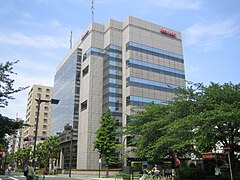Nisshinbo Holdings
 | |
 Nisshinbo headquarters building in Tokyo | |
Native name | 日清紡ホールディングス株式会社 |
|---|---|
| Company type | Public (K.K) |
| TYO: 3105 | |
| ISIN | JP3678000005 |
| Industry | Diversified industrials |
| Founded | (February 5, 1907) |
| Headquarters | Nihonbashi, Chuo-ku, Tokyo 103-8650 , Japan |
Area served | Worldwide |
Key people | Masaya Kawata (President) |
| Products | |
| Services | Leasing and selling of real estate |
| Revenue | |
Number of employees | 23,055 (as of March 31, 2016) |
| Website | Official website |
| Footnotes / references [1][2] | |
Nisshinbo Holdings Inc. (日清紡ホールディングス株式会社, Nisshinbō Hōrudingusu Kabushiki-gaisha) is a Japanese company listed on the Nikkei 225.[3] It has a diverse line of businesses that include electronics, automobile brakes, mechatronics, chemicals, textiles, papers and real estate.
History
Nisshinbo was established in 1907 as a cotton spinning business, Nisshin Cotton Spinning Co., Ltd. (日清紡績株式会社). It changed its English name to Nisshin Spinning Co., Ltd. in 1962.[4]
In the wake of World War II, Nisshin began to add non-textile segments to its business. Textiles accounted for 90% of its sales in 1960 but only 67% in 1980 and less than half by 1990.[5] During these years, Nisshinbo was part of the Fuyo Group keiretsu headed by Fuji Bank.[6]
In 2009, it adopted a holding company structure and renamed its parent company as Nisshinbo Holdings Inc.[4]
Products
Nisshinbo's textiles business remains active in the development of non-iron fabric, non-woven fabric and elastomers.[7] In 2015 it acquired Tokyoshirts, the largest men's shirt manufacturer/retailer in Japan.[8]
Nisshinbo's electronics business is focused on semiconductors and wireless equipment.[9] It manufactures drum brakes, disc brakes and friction materials for cars and trucks,[10] as well as toilet paper, wrapping paper, printer paper and other paper products.[11] In 2011 the company acquired TMD Friction and the combined business became the world's largest automotive brake friction manufacturer.[12]
Nisshinbo also operates a real estate arm, Nisshinbo Urban Development, which redevelops former Nisshinbo industrial properties for commercial and residential use.[13]
References
- ^ "Corporate Profile". Nisshinbo Holdings. Retrieved February 13, 2017.
- ^ "Company Profile". Nikkei Asian Review. Nikkei Inc. Retrieved February 13, 2017.
- ^ "Components:Nikkei Stock Average (Nikkei 225)". Nikkei Inc. Archived from the original on November 14, 2016. Retrieved February 13, 2017.
- ^ a b "History". Nisshinbo Holdings. Retrieved September 8, 2015.
- ^ "Transition of Business Portfolio". Nisshinbo Holdings. Retrieved September 8, 2015.
- ^ Watkins, Thayer. "Fuyo Group, the Hibiscus Keiretsu". San Jose State University. Retrieved September 8, 2015.
- ^ "Textiles". Nisshinbo Holdings. Retrieved September 8, 2015.
- ^ "Nisshinbo to buy Japan's largest shirt retailer". Nikkei Asian Review. February 27, 2015. Retrieved September 8, 2015.
- ^ "Electronics". Nisshinbo Holdings. Retrieved September 8, 2015.
- ^ "Automobile Brakes". Nisshinbo Holdings. Retrieved September 8, 2015.
- ^ "Papers". Nisshinbo Holdings. Retrieved September 8, 2015.
- ^ "Nisshinbo buys TMD, creates worlds largest auto brake friction company". Canadian Manufacturing. Annex Business Media. September 26, 2011. Retrieved February 13, 2017.
- ^ "Real Estate". Nisshinbo Holdings. Retrieved September 8, 2015.
External links
- Official global website (in English)
- Textile companies of Japan
- Automotive companies of Japan
- Pulp and paper companies of Japan
- Fuyo Group
- Chemical companies based in Tokyo
- Holding companies based in Tokyo
- Manufacturing companies based in Tokyo
- Companies listed on the Tokyo Stock Exchange
- Conglomerate companies established in 1907
- Japanese companies established in 1907
- Japanese brands
- Manufacturing companies established in 1907
- Brakes
- Holding companies established in 1907
- Japanese company stubs
